Overview
The article titled "7 Key Insights for Analyzing Workforce Changes in Startups" asserts the necessity for startups to adeptly navigate and adapt to workforce changes. It underscores the critical role of:
- Leveraging AI-driven analytics
- Fostering employee engagement
- Implementing feedback mechanisms
These strategies are essential for enhancing decision-making and operational efficiency during transitions. By adopting these insights, startups can not only respond effectively to changes but also thrive in a competitive landscape.
Introduction
In a rapidly evolving business landscape, analyzing workforce changes in startups is essential, where adaptability and innovation reign supreme. New ventures face the complexities of employee dynamics, and understanding the impact of technology, AI, and engagement strategies can significantly enhance their operational success.
But how can startups effectively harness these insights to not only survive but thrive amidst constant change? This article delves into key insights that illuminate the path toward effective workforce analysis. It offers strategies that empower startups to build resilient teams and foster a culture of continuous improvement.
Websets: AI-Powered Insights for Workforce Analysis
Websets employs advanced AI algorithms for analyzing workforce changes in startups, providing actionable insights into staff performance, engagement, and turnover trends. By leveraging Websets' AI-powered market intelligence tools, companies can dissect large datasets to uncover trends that shape strategic decision-making, ultimately enhancing staff management and retention strategies.
With AI's capability to and streamline recruitment processes, organizations can cut hiring costs by up to 30%, simultaneously boosting employee productivity by the same margin. Furthermore, Websets' analytics functions can accurately predict labor trends, which aids in analyzing workforce changes in startups and enables new businesses to proactively address potential challenges.
As AI continues to transform the realm of human resources, its integration into workforce management is not merely advantageous but essential for cultivating a thriving organizational culture.
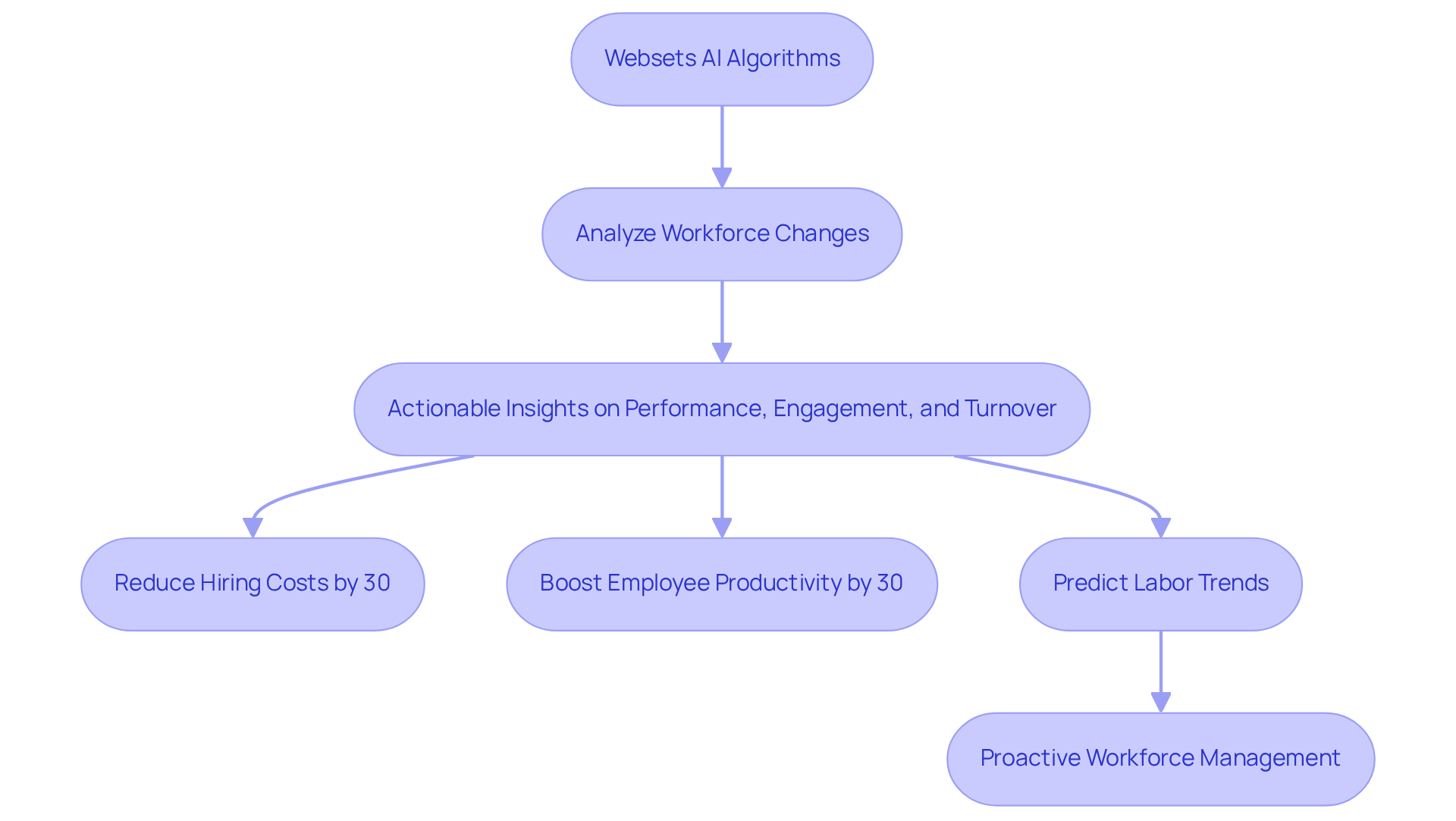
Employee Engagement: A Crucial Factor in Startup Success
Employee engagement is vital for startups, significantly influencing both productivity and retention. Engaged employees are not only more likely to generate innovative ideas but also demonstrate greater loyalty to the organization. Research indicates that engagement levels are nearly three times higher when individuals perceive their organization as responsive to survey results.
To cultivate a , startups must implement regular feedback systems that allow employees to voice their opinions and feel recognized. As Kevin Kruse aptly states, "Workforce engagement is the emotional commitment the individual has to the organization and its objectives."
Additionally, establishing effective recognition programs can enhance motivation, making team members feel valued and appreciated for their contributions. The initial excitement, pride, and optimism experienced on the first day of work are crucial for sustaining engagement.
By prioritizing these strategies and empowering direct supervisors, startups can foster an environment where employees are inspired to excel and committed to the company's success.
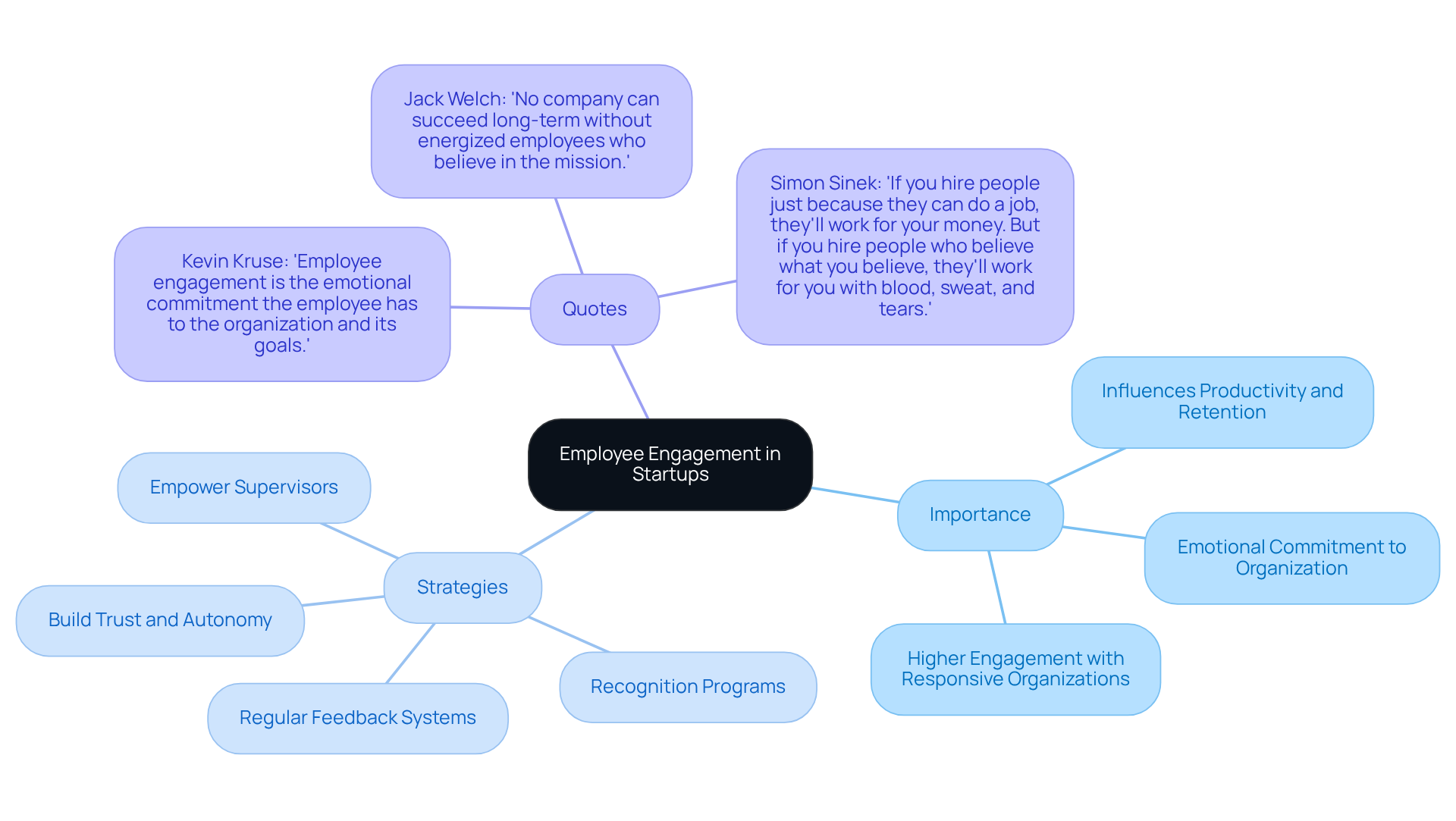
AI Transformation: Redefining Workforce Dynamics in Startups
AI is fundamentally transforming employment dynamics by automating routine tasks and delivering data-driven insights that enhance decision-making. By analyzing workforce changes in startups, companies can harness AI tools like Websets to streamline recruitment processes, significantly reducing time-to-hire by an average of 50% and improving candidate quality through better matching. With Websets' advanced AI-powered search engine—featuring the Fast API for rapid information retrieval and the Research Agentic API for comprehensive research—businesses can access unique capabilities for complex queries, ensuring they find the right talent efficiently.
Moreover, AI-driven employee training programs have been shown to increase engagement by 72%, fostering a culture of continuous learning and adaptability. By integrating Websets into their operations, new businesses can cultivate a more agile workforce, which is essential for analyzing workforce changes in startups and optimizing team performance. This strategic adoption not only but also positions new ventures to compete effectively in an increasingly dynamic business landscape. Supported by flexible, high-capacity rate limits and premium support tailored for enterprise needs, the potential for growth and success is substantial. Are you ready to embrace the future of recruitment and training?
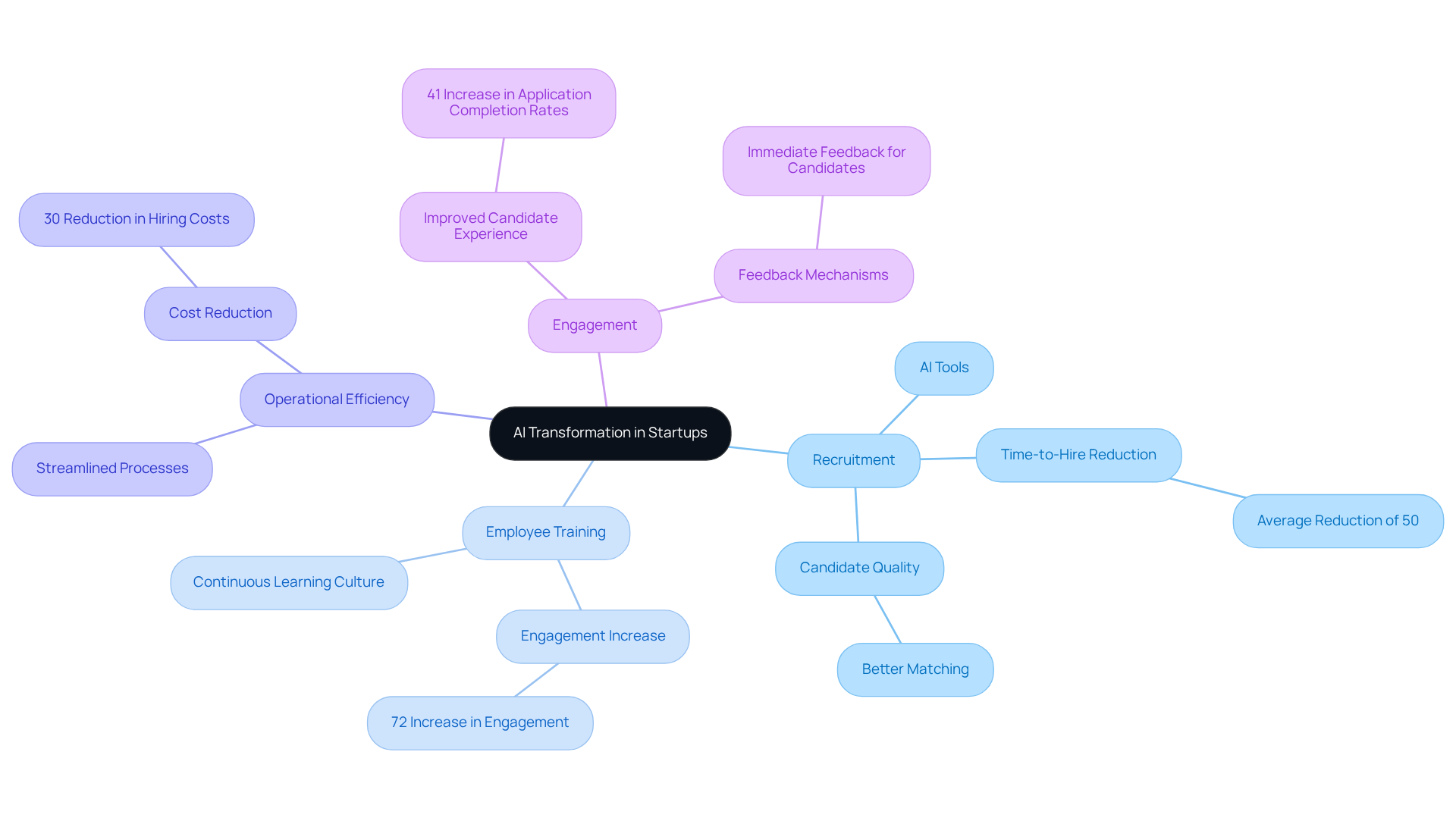
Adaptability: Navigating Workforce Changes in Startup Environments
In the fast-paced world of startups, analyzing workforce changes in startups shows that adaptability is not just a benefit; it is crucial for survival. Organizations must cultivate an environment that not only welcomes transformation but also motivates staff to consistently acquire new skills, which is crucial when analyzing workforce changes in startups. This can be achieved through various strategies, such as:
- Analyzing workforce changes in startups
- Implementing continuous learning opportunities
- Offering flexible work arrangements that empower teams to pivot swiftly in response to evolving business needs
According to McKinsey research, companies that prioritize adaptability have a 4.5 times higher chance of outperforming their competitors, underscoring the competitive edge gained through a proactive approach to change.
Successful startups often implement structured continuous learning programs, which are essential for , to enhance employee engagement and retention. A notable example is TechWave, which experienced a 40% improvement in adaptability scores after investing in emotional intelligence training. This investment not only boosted project completion rates by 30% but also cultivated a resilient workforce capable of navigating uncertainties.
Furthermore, fostering a culture of transformation involves analyzing workforce changes in startups by promoting open dialogue and feedback mechanisms. Entities with elevated communication during transitions face 70% less opposition to adaptation, as evidenced by XYZ Corporation's 50% rise in employee engagement after emphasizing communication during a technology implementation.
Business leaders consistently emphasize the significance of adaptability in their organizations. Dorie Clark asserts that being willing to learn and respond to changing circumstances is essential for sustained success. Similarly, Jacqueline Brassey from McKinsey highlights that adaptability means thriving beyond challenges, not merely enduring them.
In conclusion, new ventures that prioritize continuous learning and adaptability not only enhance their operational efficiency but also position themselves for long-term success in an ever-evolving market. Specific steps, such as implementing regular feedback loops and investing in emotional intelligence training, can further support this goal.
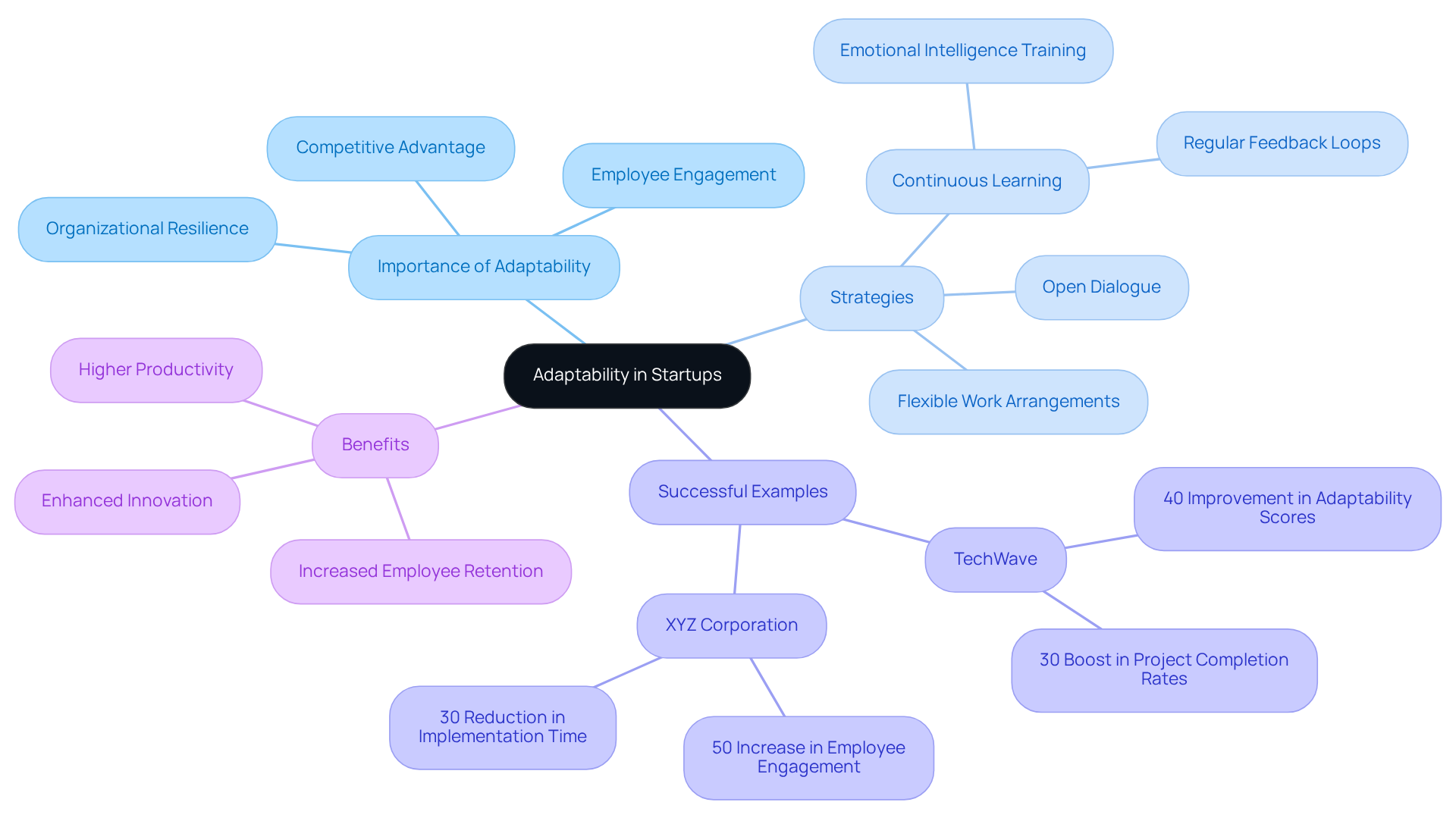
Technology Integration: Boosting Productivity Amid Workforce Changes
Incorporating technology into everyday activities is crucial for enhancing productivity, particularly during employee transitions. Startups must prioritize investment in that streamline communication and automate repetitive tasks. Platforms such as Microsoft Teams, Slack, and Zoom have demonstrated effectiveness in fostering real-time collaboration, enabling teams to remain connected and aligned, regardless of their physical locations. These tools not only facilitate organized conversations but also boost team performance by minimizing context-switching and information silos.
Moreover, project management software like Asana and Trello centralizes task tracking and management, increasing accountability and ensuring that no tasks slip through the cracks. By leveraging these technologies, new ventures empower their teams to focus on high-value tasks that drive growth and innovation.
Industry experts assert that effective communication tools bridge gaps, allowing teams to share ideas and advance projects in real-time. As new businesses navigate employee transitions, analyzing workforce changes in startups with the right tools can significantly enhance collaboration, leading to improved outcomes and a more engaged team. By fostering an environment of transparent dialogue and utilizing sophisticated collaboration tools, new businesses can adapt more swiftly to changes and maintain productivity during transitions.
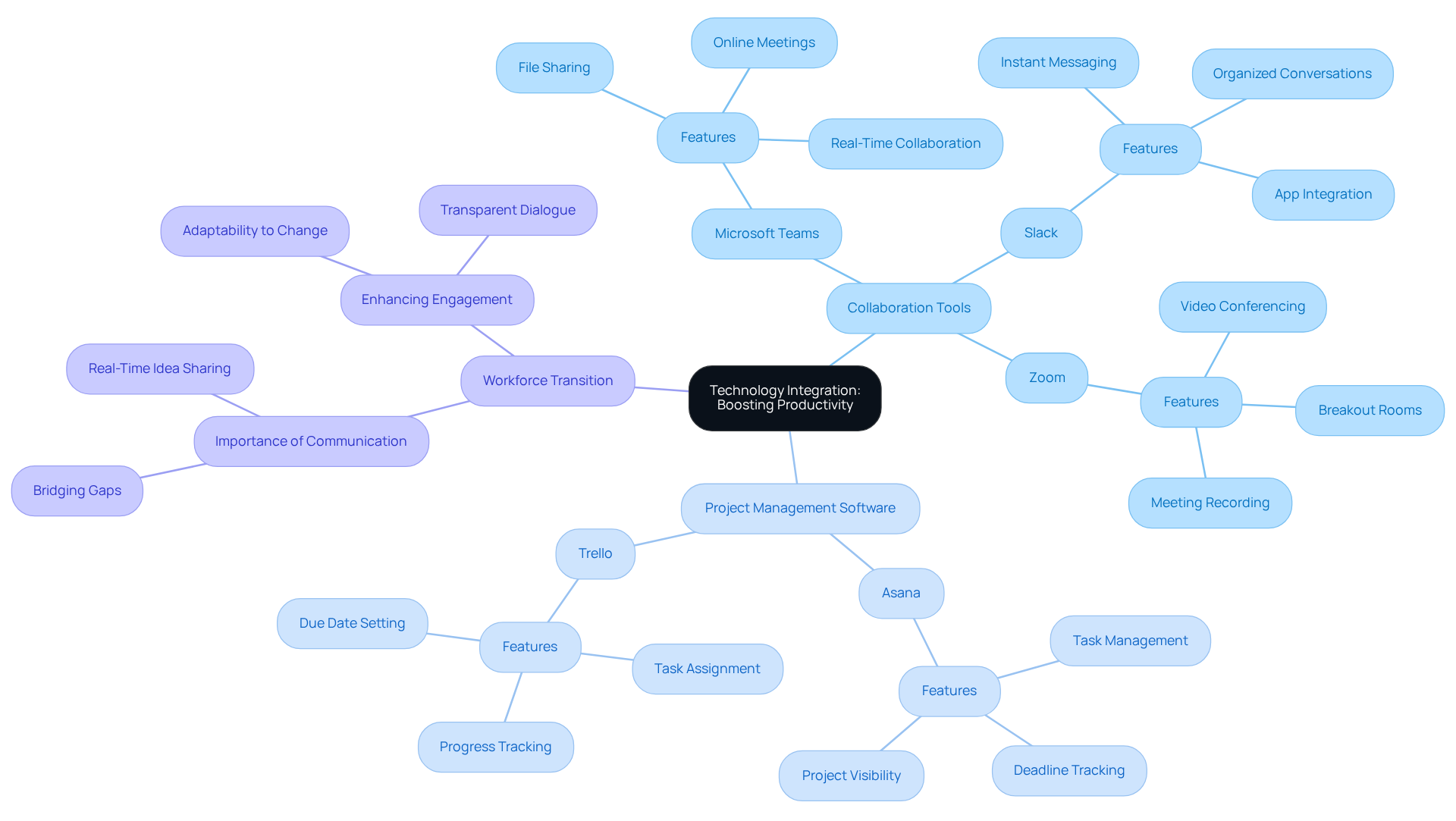
Data-Driven Decisions: Analyzing Workforce Changes Effectively
Data-driven decision-making is essential for startups that are analyzing workforce changes in startups effectively. By leveraging personnel analytics, businesses can uncover significant trends in employee performance, engagement, and turnover. This empowers leaders to make informed choices regarding hiring, training, and retention strategies, ultimately fostering a more resilient team.
Current trends reveal that new businesses are increasingly focused on analyzing workforce changes in startups to enhance operational efficiency. Organizations that harness data-driven insights can identify patterns in staff performance, enabling them to tailor training programs that address specific skill gaps. Furthermore, understanding turnover patterns through analytics allows new businesses to implement proactive retention strategies, significantly reducing the costs associated with high staff turnover. In fact, businesses lose $5.2 million in revenue due to untapped data, underscoring the financial ramifications of ineffective data utilization.
Numerous new ventures have successfully employed staff analytics, especially when analyzing workforce changes in startups, to boost personnel retention. For instance, a tech startup, XYZ Tech, analyzed exit interviews and discovered that employees departed due to a lack of career advancement opportunities. By tackling this issue through targeted development programs, XYZ Tech was able to significantly lower its turnover rate.
Analysts emphasize the growing importance of employee analytics in today’s business landscape. As W. Edwards Deming stated, "Without data, you're just another person with an opinion," highlighting the critical role of data in informed decision-making. Moreover, as organizations increasingly recognize that 'what gets measured gets managed,' the integration of personnel analytics into strategic planning becomes crucial for maintaining a competitive edge. The demand for data experts is rising at a rate of 36%, further accentuating the significance of data analytics in the industry.
In summary, the effective application of personnel analytics not only aids in identifying trends but also equips new ventures with the insights necessary to enhance staff satisfaction and retention, ultimately driving business success.
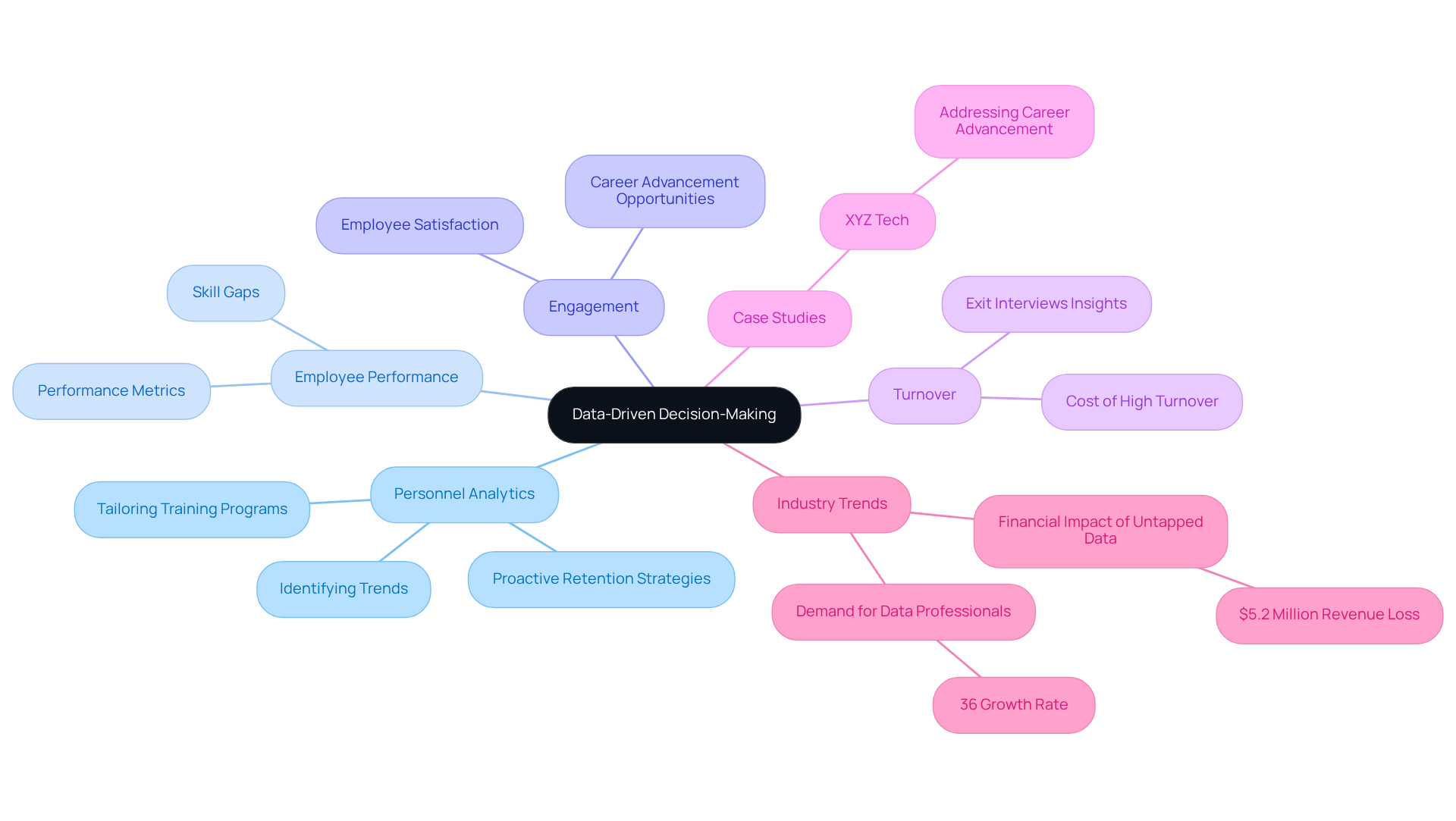
Leadership Strategies: Guiding Teams Through Workforce Transitions
Effective leadership is essential during workforce transitions, especially when analyzing workforce changes in startups where change is both frequent and rapid. Leaders must prioritize open communication about upcoming adjustments, ensuring that staff members are not only informed but also actively engaged in the decision-making process. This inclusive approach fosters a sense of ownership among team members, making them feel valued and heard. As a result, morale remains high, and teamwork flourishes, which is crucial for navigating the complexities of transition.
Research shows that organizations emphasizing open communication can significantly reduce employee anxiety, fostering a more supportive atmosphere. By incorporating motivational quotes from leadership coaches—such as
- 'The greatest danger in times of turbulence is not the turbulence - it is to act with yesterday’s logic'
- 'The world hates transformation, yet it is the only thing that has brought progress'—
leaders can inspire their teams to embrace transformation positively.
Moreover, companies adopting an employee-driven change approach complete the process approximately 33% faster than those employing a top-down strategy. This statistic underscores the effectiveness of inclusive communication practices. Ultimately, a commitment to and employee engagement is essential when analyzing workforce changes in startups, as it paves the way for smoother transitions and cultivates a resilient organizational culture.
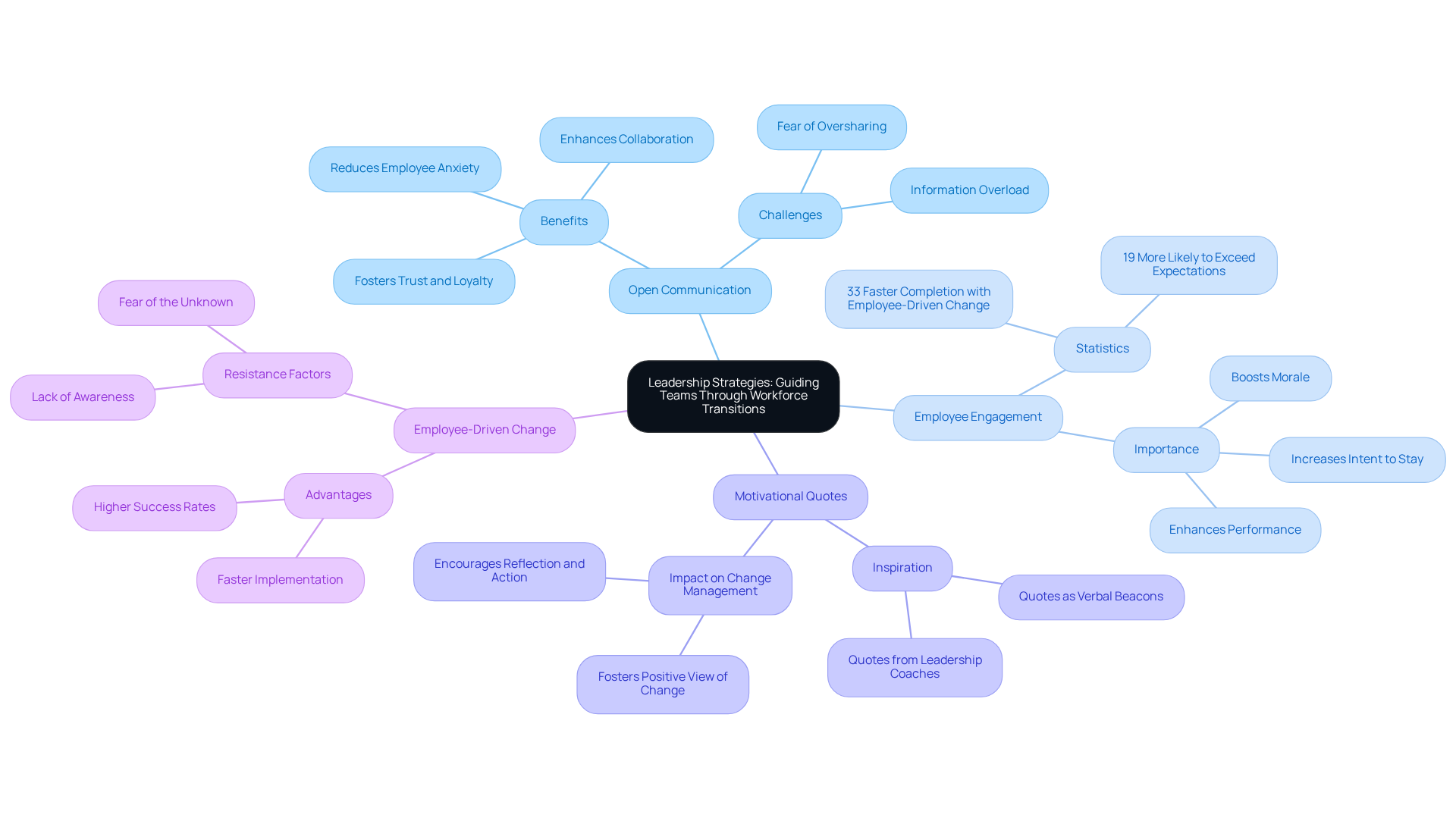
Remote Work: Shaping Workforce Dynamics in Startups
Analyzing workforce changes in startups reveals how remote work has fundamentally transformed workforce dynamics in new companies, offering both flexibility and access to a diverse talent pool. However, it also introduces significant challenges in communication and collaboration. To navigate these complexities, startups must adopt and leverage technology that fosters connectivity and productivity among team members, regardless of their physical locations.
Industry leaders emphasize the importance of maintaining structured communication to enhance team collaboration. For instance, Dan Springer, CEO of DocuSign, advocates for a disciplined work schedule to help staff distinguish work from personal time, which is crucial for maintaining productivity in a remote setting. He states, "Working from home makes it much harder to delineate work time from personal time. I encourage all of our employees to have a disciplined schedule for when you will work, and when you will not, and to stick to that schedule." Similarly, John Furneaux, CEO of Hive, highlights the effectiveness of regular video meetings, stating that they are vital for fostering team camaraderie and collaboration in a remote environment. He observes, "The most important keys to remote work at a new company have been weekly stand-ups." Having your video on completely alters the atmosphere of a meeting and is essential for a new business.
Moreover, the rise of hybrid roles—where employees split their time between remote and in-office work—has become increasingly prevalent. In Q2 2025, hybrid job postings surged to 24%, up from 15% in Q2 2023, reflecting a growing preference among job seekers for flexible work arrangements. This trend highlights the necessity for new ventures to implement successful technology solutions, particularly in analyzing workforce changes in startups, to facilitate seamless communication and collaboration among remote teams. Notably, 76% of workers indicated that flexibility in work influences their desire to stay with an employer, further emphasizing the importance of these arrangements.
Despite the advantages, new businesses face challenges in ensuring effective communication. The lack of face-to-face interaction can lead to misunderstandings and a sense of isolation among team members. To combat this, organizations are encouraged to utilize collaborative tools that promote engagement and transparency, thereby enhancing overall team dynamics.
In summary, while remote work presents unique challenges for new businesses, analyzing workforce changes in startups also reveals opportunities for innovation and growth. By prioritizing effective communication strategies and leveraging technology, new businesses can create a productive remote work environment that supports their operational goals.
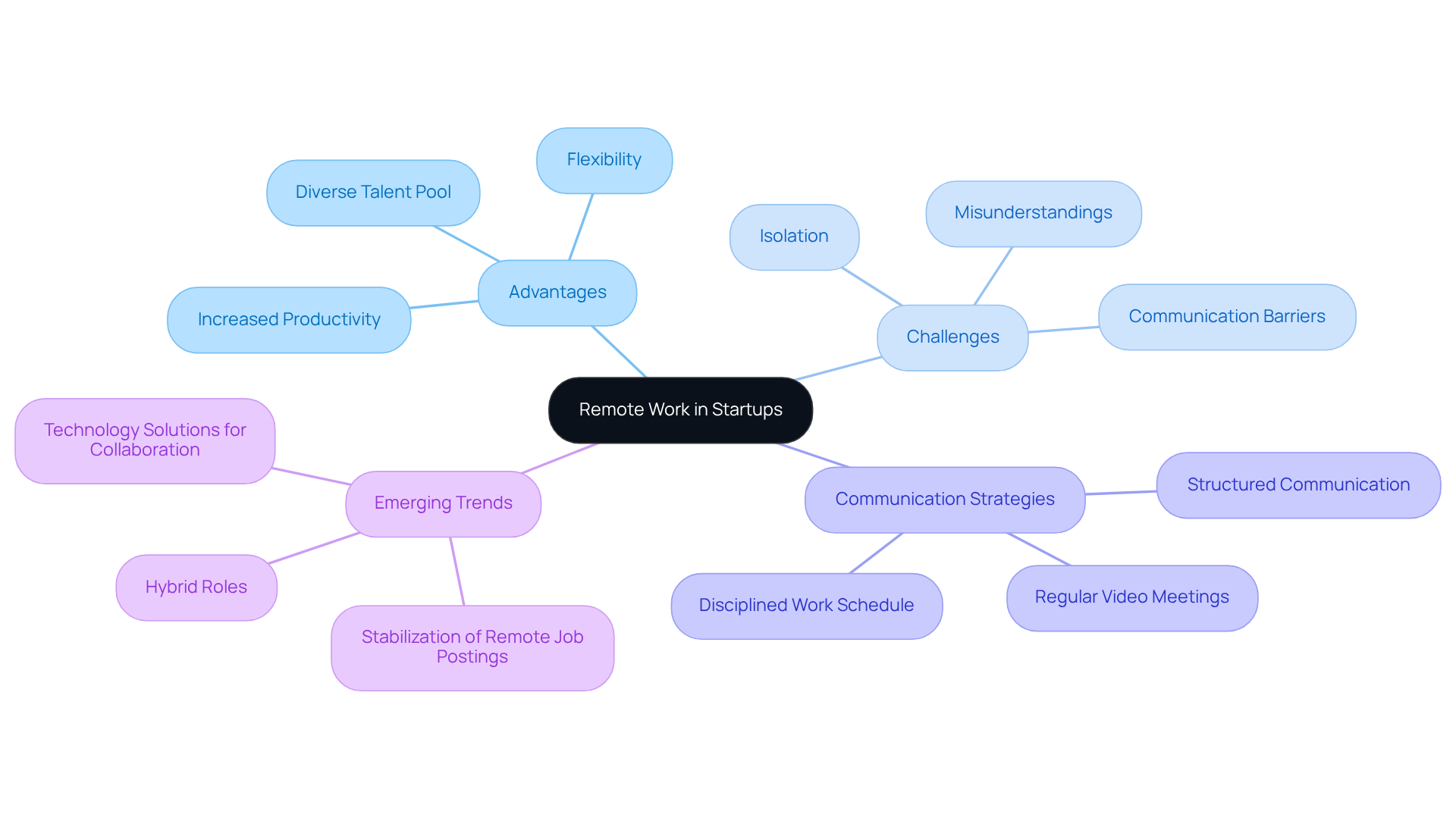
Employee Feedback: A Key Insight into Workforce Changes
Understanding workforce dynamics within startups involves analyzing workforce changes in startups through . By consistently gathering input from team members, organizations gain critical insights into their experiences and challenges. Establishing robust feedback channels—such as surveys, one-on-one meetings, and anonymous online platforms—ensures that staff feel valued, and their concerns are addressed promptly. This ongoing dialogue fosters a culture of trust and transparency, empowering employees to contribute meaningfully to the company's objectives.
Startups that prioritize feedback can significantly enhance staff engagement, drive innovation, and become more adept at analyzing workforce changes in startups. Moreover, creating a secure environment for idea expression promotes continuous improvement and underscores the importance of each individual's input in shaping the organization’s future. Notably, individuals in a high-trust environment experience 74% less stress, further emphasizing the necessity of feedback channels.
HR specialists assert that a feedback-rich atmosphere should allow staff to voice their ideas without fear of criticism, cultivating a culture of innovation. By training leaders and employees in giving and receiving constructive feedback, new businesses can ensure that feedback becomes an ongoing process that fosters continuous enhancement.
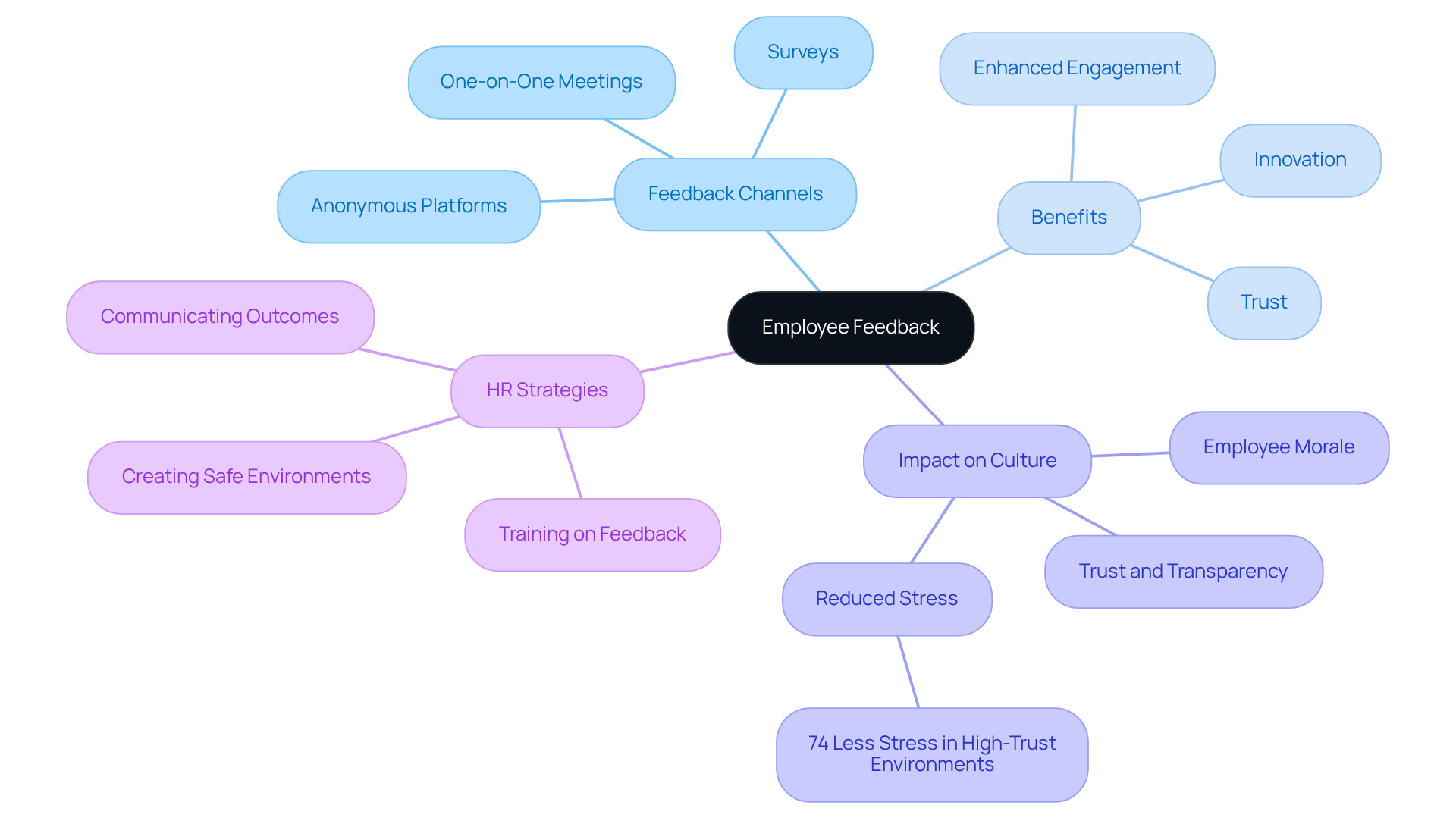
Future Trends: Anticipating Workforce Changes in Startups
As the labor market evolves, new businesses must remain vigilant by analyzing workforce changes in startups that significantly impact their operations. A primary focus is the increasing integration of AI in workforce management, which not only enhances productivity but also streamlines processes. Industry leaders assert that AI is not merely a tool; it is a transformative force capable of reshaping how teams collaborate and innovate. Sheryl Sandberg emphasizes the necessity of merging human creativity with AI's analytical capabilities to tackle pressing challenges.
Moreover, the rise of hybrid work models is revolutionizing how startups engage staff and boost productivity. Companies are adapting by fostering flexible work environments that cater to diverse staff needs, thereby cultivating a culture of well-being and collaboration. This shift is not merely a reaction to current demands; it is a strategic initiative focused on analyzing workforce changes in startups to attract and retain top talent in a competitive market.
Startups that proactively embrace these trends are essential for analyzing workforce changes in startups and positioning themselves for success. By integrating AI into their workforce management strategies and adopting hybrid models, they can significantly enhance operational efficiency and employee satisfaction. Tools such as empower new businesses to identify and optimize data, ensuring they efficiently recognize suitable candidates and leads. As Reid Hoffman notes, AI will reshape industries and create new opportunities, making it essential for startups to leverage these advancements to thrive in an ever-changing environment.
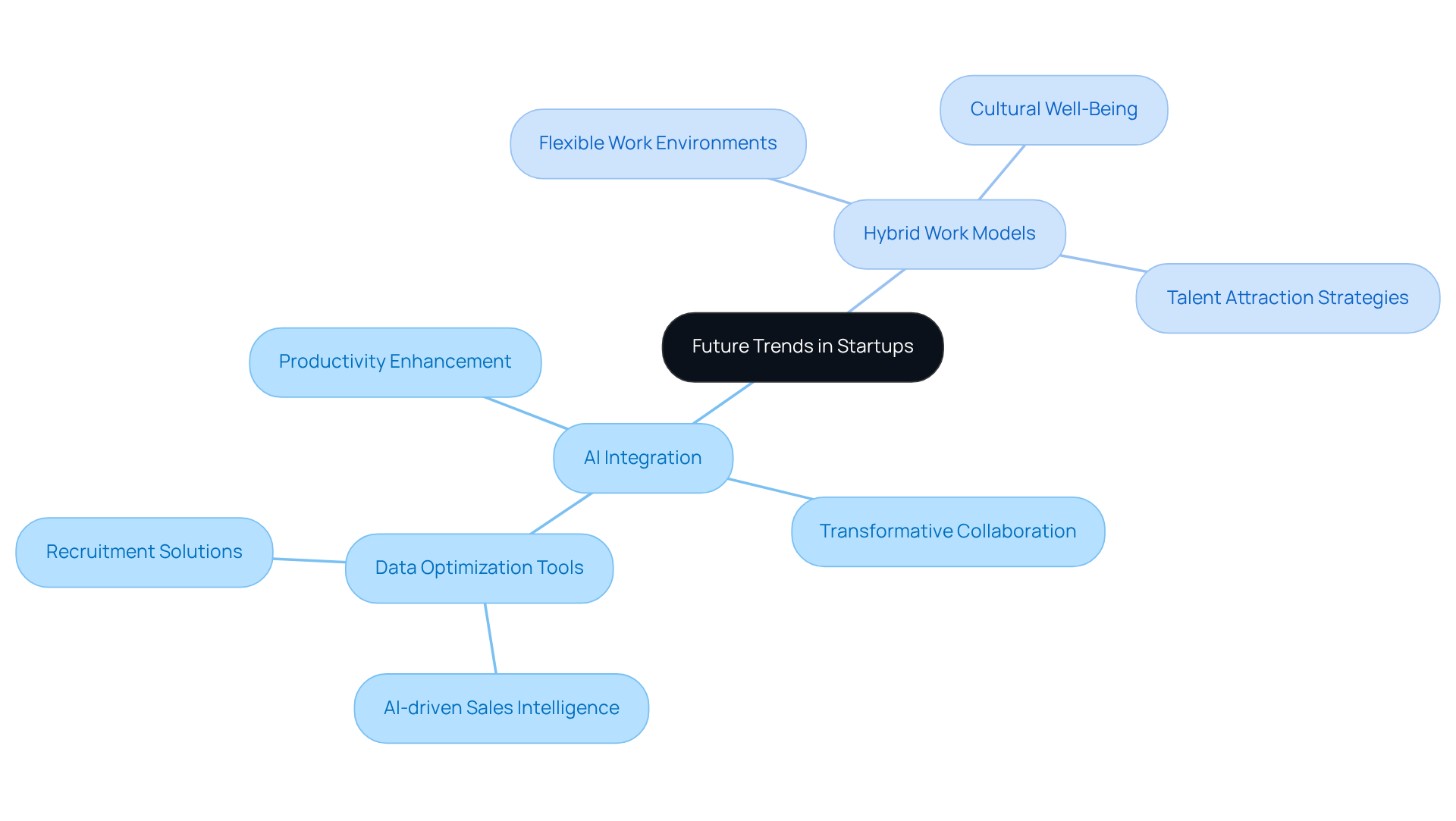
Conclusion
Analyzing workforce changes in startups is not merely about keeping pace with trends; it is a strategic necessity that can determine the success or failure of an organization. By leveraging advanced tools like AI, fostering employee engagement, and embracing adaptability, startups can effectively navigate the complexities of workforce transitions. The insights shared throughout this article underscore the importance of a proactive approach in understanding and managing these changes.
Key arguments highlight how AI-driven analytics can:
- Streamline recruitment
- Enhance employee training
- Predict labor trends
Ultimately leading to improved productivity and retention. The emphasis on employee engagement and feedback mechanisms reinforces the idea that a motivated workforce is pivotal for innovation and loyalty. Furthermore, the integration of technology and a commitment to transparent leadership strategies are essential in cultivating a resilient organizational culture capable of thriving amid change.
In a rapidly evolving business landscape, the call to action for startups is unequivocal: prioritize the analysis of workforce dynamics and invest in the tools and strategies that will not only enhance operational efficiency but also foster a culture of adaptability and engagement. By doing so, new ventures position themselves not just to survive but to flourish as they anticipate and respond to future workforce changes, ensuring long-term success in an increasingly competitive market.
Frequently Asked Questions
What is Websets and how does it assist startups?
Websets is an AI-powered tool that analyzes workforce changes in startups, providing actionable insights into staff performance, engagement, and turnover trends. It helps companies dissect large datasets to uncover trends that inform strategic decision-making, enhancing staff management and retention strategies.
How can Websets impact recruitment and hiring costs?
By forecasting skills gaps and streamlining recruitment processes, Websets can reduce hiring costs by up to 30% while simultaneously boosting employee productivity by the same margin.
What role does AI play in workforce management?
AI transforms workforce management by automating routine tasks and delivering data-driven insights that enhance decision-making. It helps organizations analyze workforce changes, streamline recruitment, and predict labor trends, making it essential for cultivating a thriving organizational culture.
Why is employee engagement important for startups?
Employee engagement significantly influences productivity and retention in startups. Engaged employees are more likely to generate innovative ideas and show greater loyalty to the organization.
How can startups cultivate a culture of employee engagement?
Startups can cultivate engagement by implementing regular feedback systems that allow employees to voice their opinions, establishing effective recognition programs, and empowering direct supervisors to create an inspiring environment.
What is the impact of AI-driven employee training programs?
AI-driven employee training programs can increase engagement by 72%, fostering a culture of continuous learning and adaptability within organizations.
How does Websets improve the recruitment process?
Websets streamlines recruitment by reducing time-to-hire by an average of 50% and improving candidate quality through better matching, utilizing advanced AI-powered search capabilities.
What are the benefits of integrating Websets into startup operations?
Integrating Websets enhances operational efficiency, cultivates a more agile workforce, optimizes team performance, and positions new ventures to compete effectively in a dynamic business landscape.




